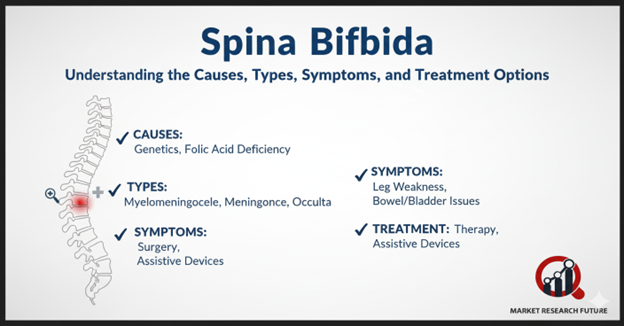Spina Bifida- Meaning, Causes, Symptoms, Types, and Treatment Meaning

Spina Bifida Market Overview
Spina bifida is a congenital condition that occurs when the spine and spinal cord do not form properly during early pregnancy. Classified as a neural tube defect (NTD), it results from incomplete closure of the spinal column, leaving a portion of the spinal cord and nerves exposed. This condition typically develops during the third and fourth weeks of pregnancy, often before a woman even knows she is expecting.
While spina bifida can lead to lifelong physical and neurological complications, advancements in prenatal screening, medical care, and surgical interventions have significantly improved outcomes. The global prevalence of this condition has declined in recent years due to better maternal nutrition awareness, particularly the intake of folic acid, and improved prenatal testing.
What Is Spina Bifida?
Spina bifida is a birth defect that affects the development of the spine and spinal cord. The condition occurs when the neural tube, which forms the brain and spinal cord, fails to close completely. Depending on the severity and location of the defect, spina bifida can range from mild, symptom-free cases to severe forms involving paralysis or neurological impairments.
Despite being one of the most common permanently disabling birth defects globally, early diagnosis and preventive care can help minimize its impact and improve quality of life.
Causes of Spina Bifida
The exact cause of spina bifida remains unclear, but research points to a combination of genetic, nutritional, and environmental factors.
Key contributing factors include:
- Folic acid deficiency: Lack of sufficient folic acid before and during early pregnancy is a major risk factor.
- Genetic predisposition: Though 95% of cases occur in families with no prior history, certain genetic mutations may increase susceptibility.
- Maternal health conditions: Women with diabetes or those taking anticonvulsant medications for seizures face higher risk.
- Environmental influences: Exposure to certain toxins, obesity, and uncontrolled blood sugar during pregnancy can also contribute.
Preventive measures—especially adequate folic acid intake—play a crucial role in lowering the risk of neural tube defects.
Symptoms and Types of Spina Bifida
The symptoms of spina bifida vary widely based on the location and extent of the defect. There are three major types:
1. Spina Bifida Occulta (Hidden Form)
This is the mildest and most common form, often called “hidden spina bifida.” The defect involves a small gap in one or more vertebrae without protrusion of the spinal cord or membranes.
- Usually asymptomatic and discovered incidentally through X-rays.
- Rarely causes complications, though some individuals may experience mild back pain, scoliosis, or leg weakness.
2. Meningocele
In this rare form, the meninges (protective membranes covering the spinal cord) push out through an opening in the vertebrae, forming a fluid-filled sac on the back.
- The spinal cord itself remains intact.
- Surgery is usually required to repair the defect.
- Most patients experience minimal or no long-term neurological issues.
3. Myelomeningocele (Severe Form)
This is the most serious and visible type of spina bifida, accounting for nearly 75% of all cases. Here, both the spinal cord and meninges protrude through the opening in the spine.
- The exposed nerves and tissues may be covered by a thin layer of skin or remain fully exposed.
- Depending on the defect’s location, symptoms can include paralysis, bladder and bowel dysfunction, orthopedic deformities, and hydrocephalus.
- Early surgical intervention is essential to prevent further nerve damage and infection.
Treatment and Management
Early diagnosis through prenatal screening—such as ultrasound, maternal serum alpha-fetoprotein (AFP) testing, or amniocentesis—plays a critical role in managing spina bifida. Once detected, a multidisciplinary care approach involving neurologists, pediatric surgeons, orthopedists, and rehabilitation specialists is recommended.
1. Preventive Care
- Folic acid supplementation before conception and during early pregnancy significantly reduces the risk of neural tube defects.
- Women planning pregnancy are advised to take 400 micrograms (mcg) of folic acid daily, increasing to 4 milligrams (mg) for those at higher risk.
2. Surgical Interventions
- Fetal surgery: Conducted before birth to repair the spinal defect in utero. While outcomes vary, early intervention may improve neurological function.
- Infant surgery: Performed within 48 hours after birth to close the defect and prevent infection. This remains the standard and most effective treatment.
3. Postnatal and Long-Term Care
- Physical therapy and assistive devices to improve mobility.
- Bladder and bowel management programs.
- Regular neurological monitoring to detect complications like hydrocephalus.
Future Outlook
The management of spina bifida continues to evolve with advancements in fetal surgery, gene therapy, and regenerative medicine. Increased public health initiatives promoting prenatal care and folic acid awareness are expected to further reduce incidence rates globally.
Emerging technologies such as 3D imaging for early detection, robotic-assisted surgeries, and stem cell-based therapies hold promise for improving outcomes and reducing lifelong disabilities associated with severe cases.
Conclusion
Spina bifida, though a serious congenital condition, is increasingly manageable through early diagnosis, preventive nutrition, and modern surgical techniques. Global health efforts emphasizing maternal wellness and prenatal screening have already led to a measurable decline in cases. Continued innovation in treatment and rehabilitation, along with widespread public education, will be crucial in enhancing the quality of life for affected individuals and minimizing future occurrences.

Leave a Comment